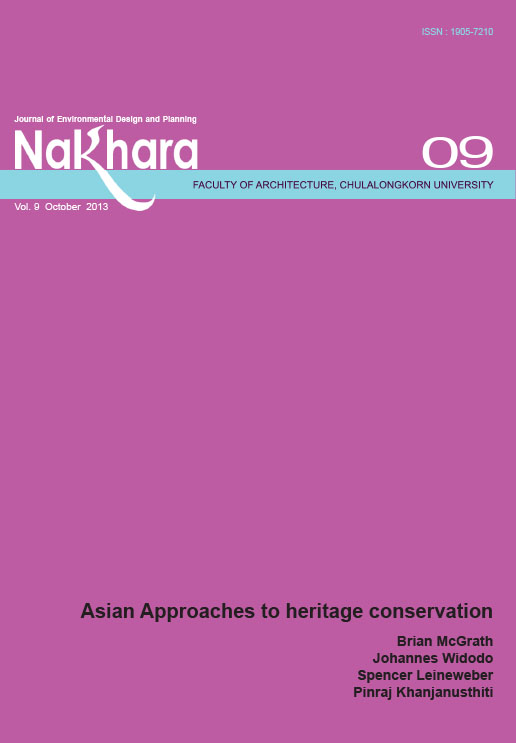Local Initiatives in the Face of Coastal Change: the Conservation of Cultural Monuments on the Upper Gulf of Thailand
Main Article Content
Abstract
Impacts of climate change and human interventions on coastal landscape have prompted local communities to preserve their cultural heritage as an emblem of local identity. This paper investigates an adaptive response of local people to the conservation of cultural monuments affected by coastal inundation and shoreline retreat of the upper Gulf of Thailand. Though conservation measures demonstrate formal and structural alterations of monuments and sites, the cultural and social attachments between communities and monuments are still maintained.
Article Details
How to Cite
Osiri, N. (2013). Local Initiatives in the Face of Coastal Change: the Conservation of Cultural Monuments on the Upper Gulf of Thailand. Nakhara : Journal of Environmental Design and Planning, 9, 69–76. retrieved from https://ph01.tci-thaijo.org/index.php/nakhara/article/view/104881
Section
Review Articles
References
Sabbioni C., Brimblecombe P., and Cassar M. (eds.)(2012) The Atlas of Climate Change Impact on European Cultural Heritage: Scientific Analysis and Management Strategies. London and New York: Anthem Press.
Naeije M., Simons W., Trisirisatayawong I., Satirapod C., Niemnil S. (2012) “Sea Level Rise and Subsidence in the Delta Areas of the Gulf of Thailand” In Proceedings 20 years of Progress in Radar Altimetry, 24-26 September 2012, Venice, Italy, vol. ESA SP-710. ESA/ESTEC.
Nathapintu S. (2009) “Bangkok of the Chao Phraya Basin”. In 225th Anniversary of Rattanakosin Kingdom. Bangkok: Amarin. pp.25-47.
Office of Natural Resources and Environmental Policy and Planning (2007). Current Situations in Coastal Erosion of the Gulf of Thailand, Bangkok. p.24.
Osiri N. and Suksawang W. (2012). The Database of Cultural Heritage Sites affected by the Coastal Changes of the Upper Gulf of Thailand. A research report funded by Chulalongkorn University.
Vongvisessomjai S. (2006) “Will Sea-level Really Fall in the Gulf of Thailand?” In Songklanakarin Journal of Science and Technology. 2006, 28(2): 227-248.
Watson D. and Adams M. (2011) Design For Flooding: Architecture, Landscape, and Urban Design for Resilience to Flooding and Climate Change. New Jersey: John Wiley & Sons, INC.
Naeije M., Simons W., Trisirisatayawong I., Satirapod C., Niemnil S. (2012) “Sea Level Rise and Subsidence in the Delta Areas of the Gulf of Thailand” In Proceedings 20 years of Progress in Radar Altimetry, 24-26 September 2012, Venice, Italy, vol. ESA SP-710. ESA/ESTEC.
Nathapintu S. (2009) “Bangkok of the Chao Phraya Basin”. In 225th Anniversary of Rattanakosin Kingdom. Bangkok: Amarin. pp.25-47.
Office of Natural Resources and Environmental Policy and Planning (2007). Current Situations in Coastal Erosion of the Gulf of Thailand, Bangkok. p.24.
Osiri N. and Suksawang W. (2012). The Database of Cultural Heritage Sites affected by the Coastal Changes of the Upper Gulf of Thailand. A research report funded by Chulalongkorn University.
Vongvisessomjai S. (2006) “Will Sea-level Really Fall in the Gulf of Thailand?” In Songklanakarin Journal of Science and Technology. 2006, 28(2): 227-248.
Watson D. and Adams M. (2011) Design For Flooding: Architecture, Landscape, and Urban Design for Resilience to Flooding and Climate Change. New Jersey: John Wiley & Sons, INC.

